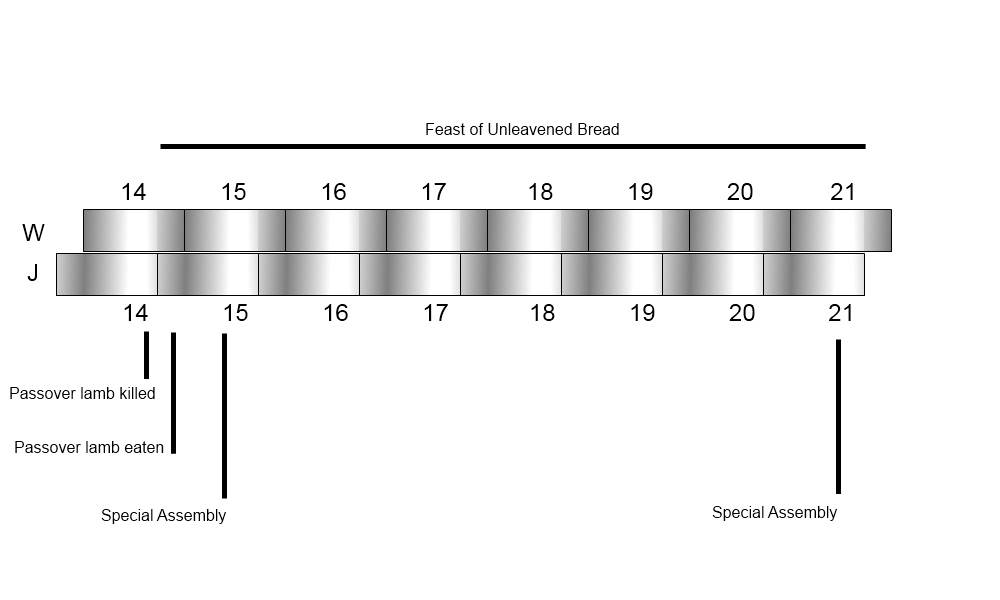Jewish Time
READING
Genesis 1:5
Exodus 12
Matthew 26-28
For a Jew the daytime that follows a nighttime is the daytime of the same day.
For us, the daytime that follows a nighttime is the daytime of the next day.
This is a brief and basic article about how the Jews divide up their calendar and count time.
If you approach the Bible with a modern Western idea of days and months you will misunderstand some references and maybe doubt the accuracy of what you are reading.
Days
In Genesis 1:5 we read “there was evening, there was morning, the first day.”
Because some of these words have connotations to our Western minds I am going to use two slightly different words throughout this explanation. Hopefully it will make things clearer.
nighttime - the dark part of the day, between 6pm and 6am.
daytime - the light part of the day, between 6am and 6pm.
So Genesis 1:5 becomes, “there was nighttime, there was daytime, the first day.”
Because of this one verse the Jewish system of counting days is very different to ours.
Jews count days from 6pm to 6pm.
A Jewish day has a nighttime followed by a daytime. (Ours is the essentially the other way around, we have daytime and then the nighttime of the same day).
It is also important to note that the common part is the daytime.
So when a Jew talks of Tuesday daytime we understand... that is what we would also call Tuesday daytime.
But... when a Jew talks of Tuesday nighttime, this is when we get confused, ... that is what we would call Monday nighttime.
Get it?
So… for a Jew the daytime that follows a nighttime is the daytime of the same day.
For us, the daytime that follows a nighttime is the daytime of the next day.
One other word that is very important is twilight. The NIV translates it as twilight, some more literal translations use “between the evenings”. For a Jew this meant late afternoon. For us, let’s stick with “late afternoon” to save confusion.
So, what immediately follows late afternoon on Tuesday?
For us it is Tuesday evening, but for a Jew it is Wednesday evening.
(this is fun isn’t it 😊)
So, what follows late afternoon on the 14th?
Yes, for a Jew it is the evening of the 15th. Late afternoon on the 14th is just a couple of hours before the beginning of the 15th.
Let’s look at a couple of examples.
In Exodus 12 God tells Moses that the Passover lamb is to be sacrificed at twilight, (late afternoon), of the 14th of the first month. And then eaten that evening.
Then, for the next 7 days they are to eat unleavened bread, (bread made without yeast).
So, what was the Jewish date when they ate the Passover?
What comes straight after the late afternoon of the 14th? Yes, the evening of the 15th.
So the Passover was eaten on the evening of the 15th, a few hours after the lamb was killed in the afternoon of the 14th. And the Exodus happened during that night so their first day of freedom was the 15th, (daytime).
The feast of unleavened bread was for 7 days... so the Jewish 15th to the 21st.
Or starting on the Western evening of the 14th and ending just before the Western evening of the 21st.
(Time for a coffee or a walk around the house?)
Maybe a picture will help.
Hours
Are you surprised that the Jews also counted hours differently?
(Wait until we get to “Months”!)
Like us, they counted hours since the start of the day. Except for us the day starts at midnight, and for them the day starts at 6pm.
The Jews counted nighttime as 6pm to 6am. So the 3rd hour of the night was what we would call 9pm. The 9th hour would be 3am.
That’s fairly easy...
They started again in the morning at 6am. So the 3rd hour of the day was 9am. And the 9th hour would be...
Yes, 3pm.
Not so hard when you remember that their day started at a different place.
Months
Yep, way different. Unless you’re Chinese.
For Westerners, months are broken up into a fixed number of days so they fit nicely into one full year. That makes it very handy because that keeps it so that January is always the same season every year. If we had a system where the months didn’t add up to a whole year then the seasons would gradually slip out of sync with the months and we’d be very confused.
It would also mean your birthday would be different every year. Or if you kept the same date, then you couldn’t simply work out how old you were by just adding up birthdays. But I think this wasn’t the main reason for keeping them the same. 😊
Western months were decided by kings and emperors. They decided how long each one was, and they have changed a few times, but not recently. For the last few hundred years we have had a nice predictable pattern that everyone knows.
For the Jews though, their months worked around the cycle of the moon. The moon cycle is about 29½ days, and every time they saw a new moon, (the first shiny bit after a dark moon), that would signal a new month. So all their months are all 29 or 30 days long.
Of course a quick check on the calculator and you realise that 365 days a year and 29½ days a month doesn’t fit together very well.
365 days is 12 x 29½ day months plus 11 days left over...
So they had 12 months and gradually the seasons got out of sync with the months.
Actually, we also have the same problem, just smaller. A year is really 365¼ days. So our Western calendar slips out of sync by a quarter of a day every year.
As I’m sure you know, we fix that by having leap years. Once every 4 years we add a day to February to keep it all lined up again.
So they did the same kind of thing. But when your month is tied to the moon you can’t just add a day! So once every few years, they added a whole month to keep everything lined up.
In Old Testament times this was done by observing the weather and the crops. If they got near the end of the year and it didn’t look like spring yet, then they added a month. This way the new year, and therefore the Passover, were always in spring.
Modern Jews use a 19 year cycle and add an extra month in the 3rd, 6th, 8th, 11th, 14th, 17th and 19th years of the cycle.
Now, for us that’s probably close enough.
But for the purposes of completeness...
(You might need to get another coffee 😊)
This bit is for bonus points, and you can skip it if you want…
To avoid ceremonial difficulties with some special days. Sometimes a day is added to one or two months to make sure there will be no problems next year.
For example, the Day of Atonement is always kept from falling next to a Sabbath to make it easier to fast.
And on the seventh day of the Festival of Booths Jews are supposed to walk around the synagogue seven times. But that can get tricky on a Sabbath, when you’re supposed to be resting, so they also make sure that the seventh day of Booths doesn’t fall on a Sabbath by “rigging” the calendar of the year before.
But I don’t think this extra day bit is relevant for Biblical study, so you can just file it away as something interesting to bring up at parties.
Hopefully that will help you understand the chronology of some of the events described in the Bible.
Like working out the events and timing of Yeshua’s last week in his earthly body.
But we will unfold that detail in another article.












